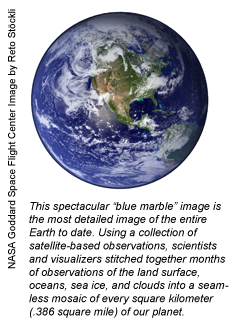Understanding the Earth's Environment from Above and from the Ground Up |
|
April 17, 2012,
Volume 58, No. 30 |
MUSA Earth Day: GIS and the Environment: April 20
 Following up its successful fall Geographic Information System (GIS) day, the Penn Institute for Urban Research will be hosting an Earth Day event Friday, April 20 to celebrate the power of Spatial Analytic technology in understanding our environment.
MUSA Earth Day: GIS and the Environment, will be held from 11:30 a.m. to 4:30 p.m. in Meyerson Hall, Upper Gallery. The MUSA (Master of Urban Spatial Analytics) degree, is a 12-month program coupling GIS skills with knowledge in an urban content area. Following up its successful fall Geographic Information System (GIS) day, the Penn Institute for Urban Research will be hosting an Earth Day event Friday, April 20 to celebrate the power of Spatial Analytic technology in understanding our environment.
MUSA Earth Day: GIS and the Environment, will be held from 11:30 a.m. to 4:30 p.m. in Meyerson Hall, Upper Gallery. The MUSA (Master of Urban Spatial Analytics) degree, is a 12-month program coupling GIS skills with knowledge in an urban content area.
Dr. Marc Imhoff, project scientist for NASA's Terra mission, will be the keynote speaker.
The Terra satellite, which was launched in December 1999, utilizes five instruments to observe Earth's changing ecosystems. Dr. Imhoff was also pivotal in the creation of Earth's City Lights, which has allowed urbanists around the world to map urbanization using satellite images of the lights cities generate at night.
Following Dr. Imhoff's presentation, representatives from the EPA, USGS and Penn will showcase innovations in GIS applications for understanding the impact of the built environment on the natural landscape.
The event is free and open to the public, and includes lunch and a closing reception. Registration is required; to register, visit www.eventbrite.com/event/3327024219
- 11:30 a.m.: Registration
- noon: Keynote Lunch Speaker: Dr. Marc Imhoff (NASA) Gray Wave of the Great Transformation: A Satellite View of Urbanization, Climate Change, and Food Security
- 1 p.m.: Dr. Matt Nicholson (EPA) The Use of GIS in Landscape Analysis and Conservation Planning
- 1:30 p.m.: Kristopher DeNardi (EPA) The Use of GIS in Assessing Potential Environmental Impacts from Mining Activities
- 2 p.m.: Jonathan Smith (USGS) Land Use/Cover Change Modeling for Biological Carbon Sequestration Estimation
- 3 p.m.: Angela Sakrison (Master Student, Environmental Studies) Identifying Suitable Land in South Jersey for Inland Migration of Wetlands in Response to Sea Level Rise
Recognizing Penn's Green Academic Offerings
The academic component that the University of Pennsylvania has included in its Climate Action Plan caught the attention of the International Sustainable Campus Network (ISCN) when that agency compiled its inaugural Global University Leaders Forum Charter report earlier this year.
Penn became a charter member of the Global University Leaders Forum (GULF) in 2010 when President Amy Gutmann signed the Sustainable Campus Charter (Almanac February 2, 2010), which commits signatories to excellence in building impacts, campus-wide target setting and an integrated sustainability approach to research, education and operations.
“How we address climate change today will affect countless generations to come,” Dr. Gutmann said. “I am proud of the progress Penn has made through its Climate Action Plan and in the many sustainability initiatives we pursue on campus. Universities have a mission to be agents of the long-range thinking that builds a more sustainable future, and our actions large and small matter.”
Penn is one of seven American universities in the 18-member Forum.
The ISCN-GULF charter report, issued in February, includes a summary of Penn’s 2011 submission. The points recognized at Penn were:
• The Climate Action Plan Academics Goal of making climate change and sustainability part of the curriculum and educational experience available to all students and to the larger campus community.
• There are more than 160 sustainability-related courses, in departments ranging from Environmental Studies to Public Health.
• A Sustainability and Environmental Management minor was established in 2009 by the School of Arts & Sciences, the Wharton School and the School of Engineering & Applied Science for undergraduate students.
• More than 140 students are enrolled in all environmental majors and minors.
• The University publishes the On College Green e-newsletter.
• “Year of Water” was the 2011 academic theme year, sponsored by the Office of the Provost.
• Behavior change initiatives have been implemented, including the establishment of a new undergraduate program in energy research, expansion of the Eco-Reps programs for outreach and engagement and the development of the Penn Green Fund which finances cutting-edge sustainability projects.
• Sustainability coordinators have been hired by many schools and centers.
As an ISCN-GULF signatory, Penn is required to submit reports on its sustainability performance for transparency (Almanac February 7, 2012) and to encourage best-practice exchange with others that practice sustainability disclosure.
In 2009, Penn developed its Climate Action Planas part of the American College and University Presidents Climate Commitment. Penn is currently the largest purchaser of wind power among US colleges and universities, requires all new campus buildings to be designed to a LEED Silver certification or higher and has increased engagement through a robust student and staff Eco-Reps program.
Additional information on Penn sustainability initiatives is at www.upenn.edu/sustainability
In the Beginning: First Earth Day . . .
Earth Day was first celebrated throughout the country on April 22, 1970 inspired by a speech by Senator Gaylord Nelson (D-Wis.) in 1969. The Earth Day celebration in Philadelphia was planned and organized by a group led by Ian McHarg, Penn's late professor emeritus of landscape architecture and urban planning (Almanac March 20, 2001) whose seminal book, Design With Nature, introduced environmental concerns to landscape architecture. The department of landscape architecture and regional planning, which he founded and chaired at GSFA (now the School of Design) was the major focus for the celebration, which culminated in 30,000 people at Belmont Plateau in Fairmount Park that spring day. On the occasion of the 30th anniversary of Earth Day, April 20, 2000, the departments of city and regional planning, and landscape architecture and regional planning, in association with the Pennsylvania Planning Association, dedicated a commemorative bronze plaque citing Professor McHarg's accomplishments and recognized his extraordinary legacy as a leader in integrating environmental principles into modern planning practice. The plaque hangs in the Dean's Alley in Meyerson Hall.
Family Day at the Morris Arboretum Arbor Day: April 28
On Saturday, April 28, the Morris Arboretum will host an Arbor Day Family Day from 11 a.m. until 3 p.m. Five stations set up throughout the Arboretum will give visitors the opportunity to be a designer, an architect or a botanist for a day; they can expand their knowledge of trees while participating in challenging and fun activities. Stations will include designing a tree house, learning to identify trees, writing the history of a tree’s life, planning an urban treescape and observing arborists at work. This program, open to all visitors, also gives 6th, 7th and 8th grade Girl Scouts the opportunity to earn their “Tree” badge. This event is free with admission. See www.business-services.upenn.edu/arboretumfor more information.

|